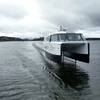Deputy Secretary of Commerce Sam Bodman joined
with shipping industry representatives today to announce that the department's National Oceanic and Atmospheric Administration (NOAA) has taken
historic steps through the International Maritime Organization to create the first U.S. zone to protect coral from anchors, groundings
and collisions from large international ships. The zone, known as the Florida Keys' Particularly Sensitive Sea Area, is more than 3,000
square nautical miles and is one of only five such areas in the world.
Starting Dec. 1, ships greater than 164 ft. in length transiting the zone will be held to internationally accepted and enforceable rules. The rules direct ship captains to avoid certain
areas within the zone altogether and abide by three no-anchoring areas within the zone. All nautical charts produced worldwide will now show
the Florida Particularly Sensitive Sea Area and address, these protective measures. More than 40 percent of the world's commerce passes through the Florida Straits each year. Ten large ship
groundings have occurred in the zone since 1984 and coral damage by rogue anchoring by large ships or freighters has occurred 17 times
since 1997.
"This rare international form of protection now awarded to fragile Florida Keys coral reefs is an example of how federal resource
managers can work closely with industry to protect vulnerable natural
resources while simultaneously supporting shipping and economic growth. Both ship trade and the tourism tied to the Keys coral reefs
have vital economic significance to the state and region," said Deputy
Secretary of Commerce Samuel W. Bodman at a news conference held in
the Commerce Building in Washington, D.C. "This protective status
makes the international shipping community aware of the coral reefs
and increases compliance with domestic measures already in place to
protect the area, while not hindering trade and commerce."
NOAA received strong support from the state government of Florida
while applying for official status of the protective zone, as well as
from U.S. shipping interests, which have been complying with similar
domestic protective policy for years now.
"The State of Florida recognizes the importance of the Florida Keys
National Marine Sanctuary and the protections that already exist on a
national scale," said Florida Governor Jeb Bush. "This is yet another
step to ensure that our international shipping community is aware of
the protections we have put in place for this unique ecosystem.
Florida has an important natural resource that must be protected."
Also speaking at the news conference in support of these measures was
Joe Cox, president of the Chamber of Shipping of America, which
represents 21 U.S.-based shipping companies, who said, "It is
imperative that the maritime industry support environmental protection
initiatives that maintain the ability to continue efficient, effective
and environmentally responsible marine transportation," he said. "The
free flow of commerce and protection of our marine environment demand
nothing less."
NOAA and the U.S. delegation worked on behalf of the State of Florida
to submit a proposal to the IMO to designate the marine area that
stretches from Biscayne National Park to the Tortugas and encompasses
all of NOAA's Florida Keys National Marine Sanctuary. The IMO is a
United Nations Specialized Agency that is responsible for issues
relating to international shipping.
The waters around the Florida Keys and the Tortugas are some of the
most heavily trafficked shipping areas in the world. Over the years,
ships have caused damage to the coral reef ecosystem through
anchoring, groundings, collisions and accidental or operational
discharges of harmful substances.
To gain approval for a protected sea area, a nation must identify
maritime-interest compliance measures with which the IMO can direct
ships to comply. For the Florida Keys' Particularly Sensitive Sea Area
these measures are four "areas to be avoided" that prevent large ships
from traveling too close to the coral reef. This amendment to the
northernmost area to be avoided was developed in response to comments
by mariners operating in the area because of the risk of collisions
that could result in devastating pollution to the reefs.
Yet another measure declares three mandatory no-anchoring areas that
protect fragile reefs in the Tortugas. While protecting the fragile
coral against the significant destruction that can be caused by the
dragging and swinging of large anchors, this measure also takes into
account the interests of shipping and commerce by continuing to allow
ships to navigate through this area.
While these measures are in place domestically, adoption by the IMO
means these areas will appear on international charts, thus increasing
mariner awareness and compliance. For instance, although the
no-anchoring zones protecting the deep reefs of the Tortugas have been
in place since 1997 and appear on NOAA nautical charts, many
foreign-flagged vessels travel the area and carry non-NOAA charts that
do not identify this zone. Thus, while anchoring incidents have
declined since 1997, NOAA continues to document violations.
The four other particularly sensitive sea areas are the Great Barrier
Reef, Australia; the Sabana-Camaguey Archipelago, Cuba; Malpelo
Island, Colombia; and the Wadden Sea proposed by Denmark, the
Netherlands, and Germany.
NOAA and the State of Florida, through a co-trustee agreement, manage
the Florida Keys National Marine Sanctuary. The congressionally
designated sanctuary was signed into law Nov. 16, 1990 by President
George Bush. It protects 2,896 square nautical miles stretching from
Biscayne Bay to the Tortugas, and encompasses some of this nation's
most significant marine resources.
Featured videos

Tracking Foreign Vessels Working in the U.S. Jones Act Market

Inmarsat Enhances Service to Drive Digitalization

Inside the Electrified Truckable Tug
Subscribe for
Maritime Reporter E-News
Maritime Reporter E-News is the maritime industry's largest circulation and most authoritative ENews Service, delivered to your Email five times per week








